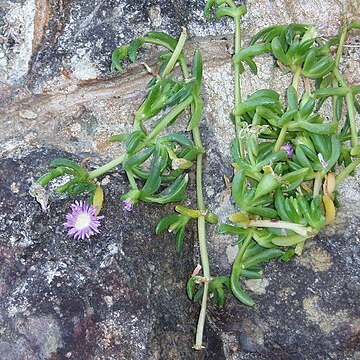Trailing herb. Stem terete, glabrous. Lvs 3-angled, acute, often mucronate, tapering to connate base, (6)-20-30-(40) × 4-6-(9) mm; margins usually smooth, rarely papillate. Fls 2-4 cm diam. Petals uniformly white to deep pink, in 3-5 rows, 1-3 cm long. Stamens 4-6 mm long; inner filaments hairy at base. Stigmas (5)-6-8-(10). Capsule valves with parallel or ± divergent expanding keels; placental tubercle rounded or 0. Seeds brown, obovoid, rugose, c. 1 mm long.
A plant that keeps growing from year to year. It grows 50 cm high and spreads 50 cm wide. The stems are succulent and red. They form mats. The leaves are bright green and triangle shaped in cross section. They are 2 cm long. The flowers are pink and at the ends of the branches. The flowers open in the middle of the day.

